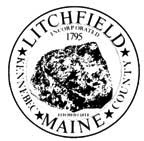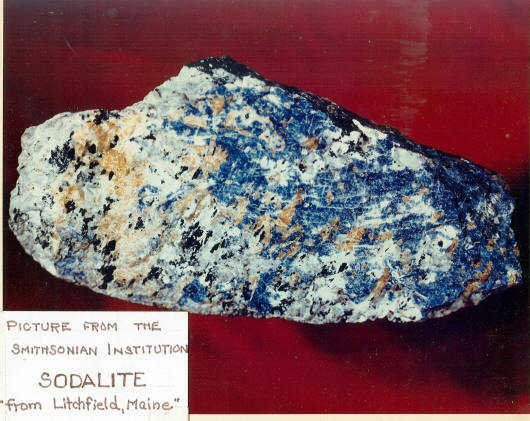|
Granite, Sodalite, Litchfieldite And Other Minerals
|
|
 The Litchfield Town Seal
|
The piece of Litchfieldite depicted on the town seal was donated to the Town by the late Hayden Anderson, one of the editors of the original "Litchfield Yesterdays." Unfortunately, the mineral was destroyed when the town office burned in 1981. The seal was designed by Brian Kent, editor of the bicentennial edition of the "Litchfield Yesterdays." |
| The best granite
quarry in town may have been the one south of the present
Whippoorwill Road at Purgatory on the old Bartlett farm. That
quarry, once owned by Robert H. Gardiner of Gardiner, furnished
granite not only for the walls of the "stone house" at Purgatory but
also for the stately exterior of Christ Church at Gardiner, built in
1820. Of the many minerals of interest to geologists as well as "rock hounds" that have been found in town, the deep blue sodalite, found in only a few other locations in the world, is the most notable. At the Smithsonian in Washington a handsome specimen, marked "from Litchfield, Maine" is displayed not far from the Hope diamond. A mineral mass defined as a "soda-rich syenite found at Litchfield, Maine" and containing besides the brilliant yellow cancrinite and black lepidomelane has been officially named "Litchfieldite", thus bringing distinction to the town believed to be one of the two sources in the world of that mineral complex. Another product of mineral origin - common clay - was widely used in town for making brick for such buildings as the Plimpton House at Purgatory, the Magoun House on the Hallowell Road, the Whittier School on the Stevenstown Road, the Brick School at the center, the Waterman-MacWhinnie House, and Bachelder's Tavern. By 1895, however, Simeon Goodwin's kiln at Purgatory "was the only one still in operation in town." Vivian Weston says that the Whittier School, and no doubt Dr. Jerry Rountree's house and the Cook house were built of brick from a yard on the Lunt's Hill Road east of the Cook and Bowley places. Water was taken from the brook at the foot of the "sharp hill which was always called 'Brickyard Hill.'" source: Litchfield Yesterdays
|
|

|
|